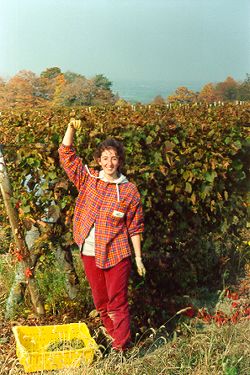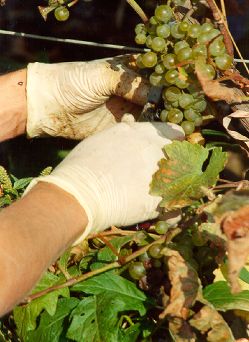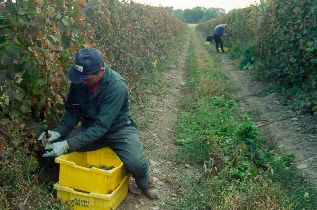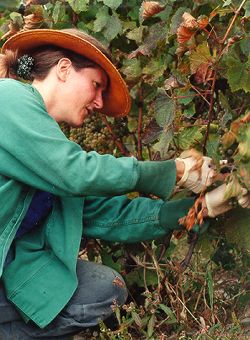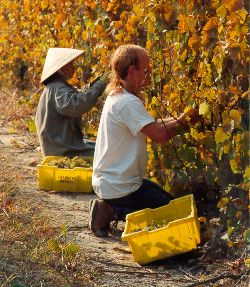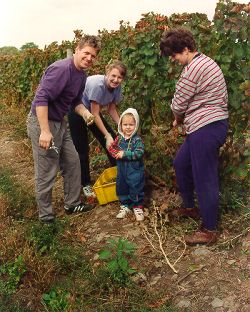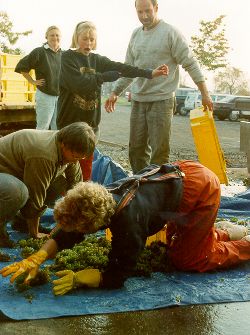|
Knee pads...Water bottle...Sunhat...
Reviewing a mental list of all the things I'd thought of to improve Day Two of my tour of duty as grape picker, I dragged my aching body out of bed this past Columbus Day. I'd signed on for the harvest at Treleaven, a small, family-run winery located 20 minutes north of Ithaca in King Ferry, New York. "Grape Pickers Needed," the ad read. Being between feature films (or similarly gainful employment)--and wanting an excuse to spend these gorgeous mid-October days out in the Finger Lakes sunshine--I showed up early on the first day of Chardonnay picking. Treleaven is one of the few wineries that still picks by hand. Owners Peter and Tacie Saltonstall, both in their early forties, believe that by avoiding mass production and mechanized cultivation and harvest, the finest grapes are produced--the basis of a superior wine. They hire 25-30 pickers each year to help bring in the harvest, which totaled close to 60 tons this year.
Day One: Getting the Rhythm
It looked pretty easy. I was eager to pull on my surgical gloves, grab a set of clippers, and pick a little, talk a little...pick, pick, pick, pick! A fast picker, Tacie said, could do 40-50 lugs a day--at $2 apiece, not bad money. But if I needed to go slower, in order to pick out the botrytis, I should. She'd make sure everyone got at least $5 an hour, even if we got assigned to clean-up.
I soon settled into a rhythm. It didn't hurt that they placed me across from Mr. Sax Man (a.k.a. Mark Wienand), a 24-year-old Ithaca School of Music grad who helped me get my time and rhythm running smooth. He also cued me when my lugs were too full--or not enough. These aptly named bright-yellow grape carriers need to hold just about 30 pounds of grapes. But in his zeal, his ardor for the arbor, Mark had a way of snipping into his own fingers almost as often as he did the vine. I think it was a three Band-Aid morning. I kept my fingers as far away from his clippers as possible. With nobody looking, I popped a few especially luscious-looking clusters into my mouth. Ah! Like a little sip of young wine, the juice was sweet--but not too sweet--better than any I'd ever bought in a market. Absolutely delicious! I sampled quite a bit that first day. "The Chards this year are dynamite," Peter later admitted to me up at the winery. "Yeah, we're getting great sugars off the Chardonnays we just picked," Tacie exulted, as she rinsed oak barrels in readiness for the fermented juice to come. A Little History
It's the Chardonnays and
Rieslings, though, that have earned Treleaven its highest plaudits: the most
recent honors just rolled in from the New York Wine and Food Classic,
Back to Work
Gail Fish and her fiance Todd Thompson, both from Van Etten, were between jobs, too. (He's used to working as a printing press operator, and she's done all kinds of work.) "We came because we like being outside." Todd explained. "The worst thing about it?" Gail laughed, "My back!"
Harriet Zbikowski, who holds a masters' in landscape architecture from Cornell but says, "I haven't figured out yet what I want to do when I grow up," wasn't sure if she wanted to come back for Day Two. Steve McKay impressed me with his technique. I came upon him at the end of a row, picking across from his 12-year-old son David, off from school for the Columbus Day recess. Steve was carefully perched on top of two lugs, sliding along like greased lightning even as we talked. I'd never seen anyone pick so fast. "It's a chance to do something, rather than THINK about doing something," says McKay, a Cornell University employee who's taken time out from his job as a fruit and vegetable farm manager to pick grapes at Treleaven for the past three harvests.
And then I met the Javors, a lovely young family who emigrated from Bosnia just three years ago. The 22-month-old Alma peeked shyly through a grapevine, smiling broadly as I made silly faces. I spoke with her 12-year sister Edina for several minutes before I realized English was not her native language. (My first clue was when I asked her if she'd ever picked grapes before and she said, yes, actually, she had--in Croatia.) I was even more amazed by this young woman's aplomb when she began translating our conversation for her parents, Zmina and Sead, both of whom are deaf. Bosnian Sign Language, Edina informs me, is quite different from its American cousin. It was time for me to go back to my half-filled lug. Chardonnay Dreams
It's thanks to Tacie's brother, the handsomely mustachioed John Balliett, that I learn about Oliver's preferences. Balliett, who spent a year's apprenticeship at Treleaven before he took on the job of vineyard manager this past spring, tells me he gave up a life of traveling amidst the jet-set crowd to settle down in King Ferry. (He specialized in architectural landscaping for the well-heeled, it seems. Somehow the perks included access to estates in the French Riviera and driving the occasional Rolls.) "It gets easier," John promises me, as he walks along the rows, smiling his encouragement, making sure we're not missing any clusters.
"This year is the latest pick ever," Peter says, as he dumps lug and after lug of just-picked Riesling into the new press that takes about three hours to process four tons of grapes. (I get a little thrill as I watch him unload the lugs with the white sticker that says "27" on it--I picked every one of those grapes!) "When you plant vinifera,
you have to be close to the lake," Tacie explains, in order to protect the
vines from a too-early frost. This year, she says, "If the vineyard had been
another quarter-mile east, we'd have had to pick it all right away."
Just being in the vineyards, overlooking the beautiful blue Cayuga Lake below, is really very pleasant.. The tranquil quiet is broken at regular intervals by a loud recording of a bird in distress, designed to keep marauders at a distance. (Judging by the many carefully constructed tiny nests I discover in the vines, the device works with limited success.)
Like all the workers at Treleaven, Kim doesn't have any particular title. She just does everything that needs to be done, and then some. "Hang on!" Kim yells, with a good-natured laugh. "We call this the 'Hardly,'" she explains, gunning the two-seater Harley-Davidson golf-cart skillfully down the water-logged, rutted row, "Because it's hardly a Harley!" That day I talk with a retired farmer, who rails against the increasing mechanization of farm life, and eavesdrop on two teenage boys discussing an upcoming chemistry exam. I ask 17-year-old Carl Strickland why he's chosen to come pick grapes at King Ferry. Paying off a $1,200 insurance bill for his aging Ford truck is his first answer, but as I watch him flirting through the vines with the lovely Kezia Parseghian, 16, I decide he must like being out here for other reasons, too. There's something that draws us all back, day after day. (In Carl's case, I suspect Kezia--who he's nicknamed Fred--has a good deal to do with it.)
"I like it here," says Kezia/Fred, who figures picking grapes is part of her home-schooling education. (She's already written eight-and-a-half manuscript pages about her experiences at Treleaven.) She and Carl entertain each other, making up new lyrics to old tunes as they pick: "There is a place in King Ferry/They call the winery..." he sings. "It's been the ruin of many a poor boy/And Lord, I know, one's me!" Cheaper Than Therapy
On the next-to-last long day, when we're all really pumping to get the last few rows done, there are two very young girls snipping away with great speed. I ask how they came to be picking. Hattie, 12, explains she didn't have much of a choice: she and her sister Courtney, 15, are the owners' daughters. "I'd rather be riding my roan, Spider," Hattie grumbles. But, she explains, their parents need them to help out today. And they'll get paid, too. Though Courtney plans to become a scientist specializing in research on animal diseases, Hattie (who claims she started picking at age 6 and pronounces Treleaven's Chardonnays "the best") dreams of being a prize-winning equestrienne [delete star}. Oh, and maybe she'll have her own vineyard someday, too.
Long Days and Longer
Nights Though Tacie says she leaves the winemaking up to Peter, she works right alongside him, hauling, cleaning, loading, and helping supervise Treleaven's staff of four full-time and 12 to 15 part-time employees. One morning, we talk--shout, actually--over a row of barrels lined up inside the winery, as she's pumping in some of the '96 Chardonnay. The barrels, which hold 58.5 gallons apiece, she informs me, are clearly marked with "C2," indicating they hold the results of the second day of picking Chardonnay. She's filling them three-quarters full, to allow for fermentation.
She explains that although they prefer the French oak barrels, with their current price tag at as much as $650 apiece, Peter's begun to experiment with American barrels, which can be had for between $100-$250. "But American barrels can be astringent," he says, explaining he's recently found a source for nicely made Hungarian ones that go for less than $400, a compromise for which he and other area growers have "high hopes." When I ask Tacie whether Treleaven's turning a profit yet, she says simply, "We pay our bills." While the winery does 60 percent of its sales in the adjacent tasting room, maintaining a regular presence with free samplings at the farmers' markets in Ithaca and Syracuse has helped increase its visibility. And Treleaven wines are now available in restaurants throughout the state. "If you don't see New York State wine on the menu," Tacie tells me, "Ask for it!"
The Harvest's In
"In fact, back when I was
a poor, struggling young writer, " I'll say with a laugh, as I start to tell
my tale, "You'll never believe this, but...."
©TLC Productions 1999. All rights reserved. | ||||||||||||||||||||||||||||||||||||||||||||||||||||||||||||
